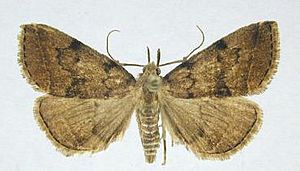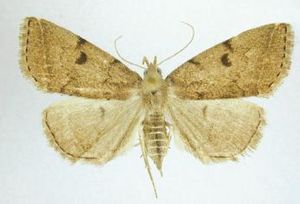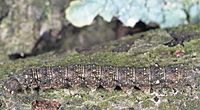Coastal plain zanclognatha facts for kids
Quick facts for kids Coastal plain zanclognatha |
|
|---|---|
 |
|
| Male | |
 |
|
| Female | |
| Scientific classification |
Zanclognatha dentata, also known as the coastal plain zanclognatha, is a type of moth that belongs to the Erebidae family. It's often called a 'litter moth' because its caterpillars sometimes eat dead leaves. Scientists David L. Wagner and Timothy L. McCabe first described this moth in 2011.
You can find this moth across North America. It lives from Ontario and Nova Scotia in Canada, south through the Great Lake states, and down into the Appalachian Mountains, reaching northern Georgia. It has also been seen in central South Carolina.
Contents
Meet the Coastal Plain Zanclognatha Moth
The coastal plain zanclognatha moth is a small insect. Its front wings are about 10.5 to 13 millimeters long. That's roughly the length of a small paperclip!
These moths have wings that are shaped like a triangle. Their colors can range from a light tan to a dark chocolate brown. They usually have clear markings on their wings.
Wing Patterns and Markings
The front wings have special lines and spots.
- The antemedial line is near the base of the wing. It looks like a row of teeth or scallops.
- There's usually a clear discal spot in the middle of the wing.
- The postmedial line is further out on the wing. It's also toothed and gets thicker where it meets the front edge of the wing.
- A straight subterminal line is near the outer edge. It has a few pale scales.
The back wings are brown. They have a faint discal spot and some lines that can be more or less visible.
Life and Habits of the Moth
These moths usually have one generation each year in most places. They fly during the middle of summer, from late June to early August. In some areas, like western North Carolina and northern Georgia, they might have a small second group of moths flying in early September.
Where Moths Live and What They Eat
Adult moths have been found in many different places. These include:
- Wetlands like bogs, swamps, and marshes.
- Forests with hardwood trees or those in mountain coves.
- Different types of conifer (pine) forests.
- Areas with pitch pine trees and scrub oak bushes.
Scientists have caught these moths using lights and sweet bait.
What the Caterpillars Eat
The young moths, called larvae or caterpillars, have a special diet. They eat dead, brown, and slightly wet leaves. Some of the trees whose leaves they munch on include:
- Abies balsamea (Balsam Fir)
- Tsuga canadensis (Eastern Hemlock)
- Pseudotsuga menziesii (Douglas Fir)
- Hamamelis virginiana (Witch-hazel)
- Lonicera morrowii (Morrow's Honeysuckle)
The caterpillars themselves are mottled, meaning they have patches of brown, red, and yellow. They also have a noticeable pale spot on their back.
Why the Moth is Called Dentata
The name dentata comes from the Latin word for "toothed." This name was chosen because of the toothed or scalloped lines on the moth's front wings. It's a good way to describe one of its unique features!



